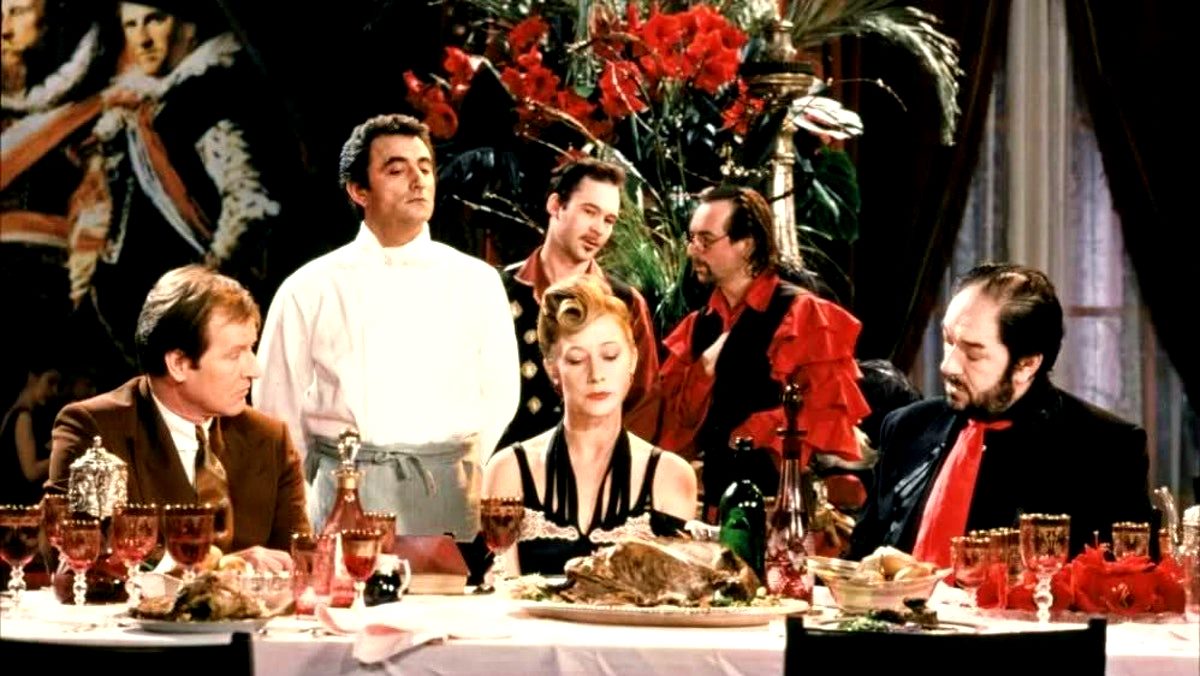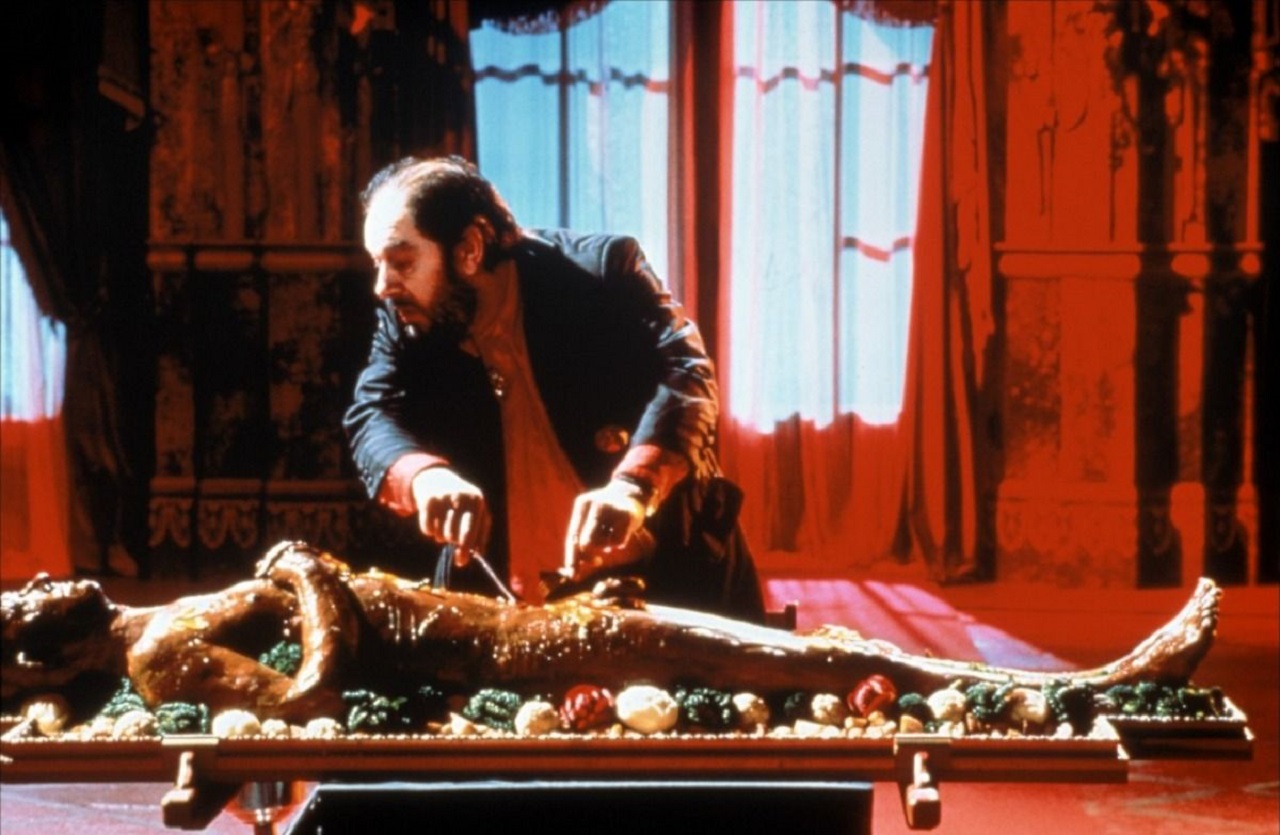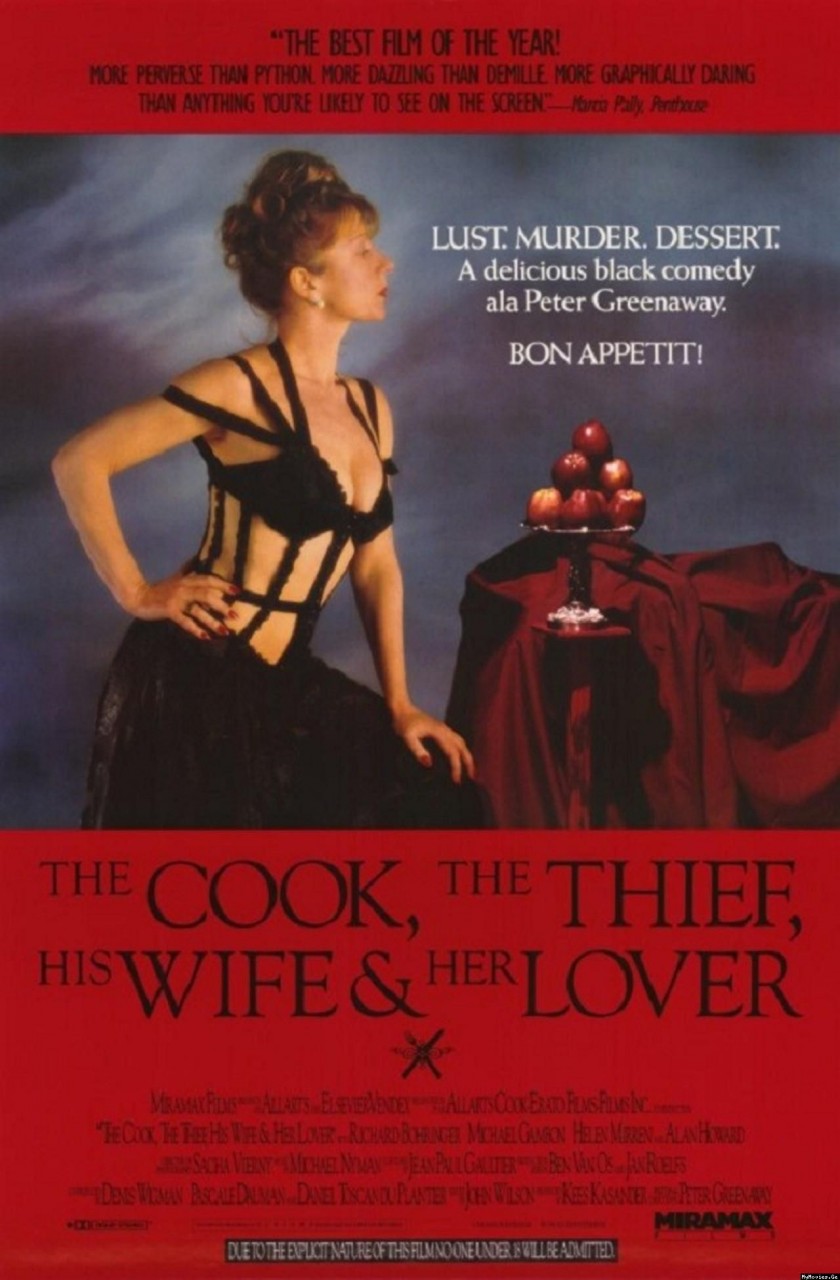UK/Belgium. 1989.
Crew
Director/Screenplay – Peter Greenaway, Producer – Kees Kasander, Photography – Sacha Vierney, Music – Michael Nyman, Makeup – Sjoerd Didden, Production Design – Jan Roelfs & Ben Van Os. Production Company – Allarts/Elsevier Vendex an Allarts/Erato Films/Films Inc.
Cast
Michael Gambon (Albert Spica), Helen Mirren (Georgina Spica), Alan Howard (Michael), Richard Bohringer (Richard Boarst), Tim Roth (Mitchell)
Plot
Petty crime kingpin Albert Spica has pretensions of the high-life and holds nightly court with his uncouth cohorts in the French restaurant that he owns. Spica’s wife Georgina makes eyes with Michael, an intellectual bookseller who dines there. Nightly, the two begin a secret affair at the back of the restaurant, hidden from Spica with the help of the French chef. When Spica eventually learns about the affair, he rages through the restaurant, inflicting brutalities upon all and sundry. He catches Michael and kills him by forcing him to eat the pages from his own books. And so Georgina decides to inflict a particularly cruel and appropriate fate upon her husband.
Peter Greenaway is perhaps the most eccentric of directors at work today. He constructs films as elaborate, piquant often obscure intellectual jokes. His more obscure films – The Falls (1980), A Zed and Two Noughts (1985) and his legion of early shorts – are filled with an obsession with formalism, symmetry, surrealism and esoteric jokes. The Falls, for instance, is a three-hour series of interviews with people whose names begin with ‘Fall–’ being queried about a never-explained catastrophe. Drowning By Numbers (1988) was an entirely frivolous joke filled with a count of numbers from 1-100 placed in the background throughout, recitations of rules for unknown games and three women all of the same name killing their husbands; and the Tulse Luper suitcases films, an elaborate sprawling mock biography listing a series of suitcases filled with random items from somebody’s life.
Nothing Greenaway has done since has quite matched the elegant rondeau of sexual games in the exquisite, mockingly formal period piece The Draughstman’s Contract (1981). Certainly, The Cook, The Thief, His Wife & Her Lover has been Greenaway’s greatest commercial success to date. Here Greenaway’s great joke is in having all the characters colour-matched to each room – every time they enter a new room their clothes inexplicably change to match the colour scheme of the room.
In so much as a Peter Greenaway film might be said to have a point – Greenaway films usually just are – The Cook, The Thief, His Wife & Her Lover is Greenaway’s joke on the snobbery of fine dining. The film is exquisitely dressed, filled with beautifully elegant arrays of colour-coordinated set dressings and blinding salmon-on-white toilets. The photography is ravishingly beautiful – some of Alan Howard and Helen Mirren’s lovemaking in daises of wheat and amid racks of pheasants are stunning in the perfect rustic arrangements of dressings and lighting.


Many of Peter Greenaway’s films from this point onwards have become fascinated with taboo breaking. Here Greenaway constantly contrasts all the good eating and high society elegance with sharp violence. Amid these exquisite surroundings, Michael Gambon goes about his thuggish business, brutalising his wife, other diners and cohorts alike with his combination of bullying and an insistence on the manners of good eating with a menu he can only pronounce in pidgin French. The film opens with a brutalised victim forced to eat faeces and then being urinated upon. All the violence forced upon characters – shit-eating, button-eating, paper-suffocation, forced eating of soup and the final macabre cannibalistic joke – is related to eating, making The Cook, The Thief, His Wife & Her Lover perhaps the first film about the horror of rapacity.
Food is used as all manner of symbolism – at one amusing point, the slicing on cucumbers, cauliflowers and the splitting of peppers is intercut with Helen Mirren and Alan Howard’s lovemaking. The effect is rather sophisticatedly decadent. Indeed, this is one of Peter Greenaway’s best works – the droll lightness of touch that eludes many of his later works comes off just perfectly.
The other Peter Greenaway films of genre note are:– the abovementioned The Falls (1980); several episodes of the modernised tv series A TV Dante (1989-91); Prospero’s Books (1991), Greenaway’s interpretation of Shakespeare’s The Tempest (1611); The Baby of Mâcon (1993), a barbed period comedy about a divinely conceived child; and The Tulse Luper Suitcases: The Moab Story (2003), The Tulse Luper Suitcases, Part 2: From Vaux to the Sea (2004) and The Tulse Luper Suitcases Part 3: From Sark to the Finish (2004), a surreal mock biography that is part of a mammoth multimedia work from Greenaway. The Greenaway Alphabet (2017) is a documentary about Greenaway.
Trailer here


